Numerical Simulation of Low Salinity Water Flooding on Core Samples for an Oil Reservoir in the Nam Con Son Basin, Vietnam
Abstract
:1. Introduction
2. Overview of LSWF Mechanisms and Governing Equations
2.1. LSWF Mechanism
2.2. LSWF Governing Equations
3. Numerical Simulation and Validation of LSW Core Flooding
3.1. Finite Volume Formulation of Ion Transport Equation
- Superbee:
- Minmod: and
- Sweby:
3.2. Coupling Chemical Component Transport with Chemical Reactions
3.3. Validation of the LWSF Simulation Results with Those of a Core Flooding Experiment
4. Simulation of LSWF for the Lower Miocene oil Sand in Chim Sao Field, Nam Con Son Basin
4.1. Geology of the Study Site
4.2. Results and Discussion
5. Conclusions and Recommendations
- Based on the results of a laboratory core flooding experiment conducted for the Ruby oil field in the Cuu Long Basin concerning a low salinity water flooding (LSWF) of the Lower Miocene sand, the multiple ion exchange (MIE) was identified by [8] as one of the most suitable mechanisms for this oil sand. The simulation conducted in this study also has confirmed the same for the Lower Miocene sand in the Nam Con Son Basin;
- A new computation code based on the finite volume element (FV) method was successfully developed in this study to simulate the ion transport in the aqueous in coupling with chemical reaction. The numerical simulations were run, and the results were compared with and are well-validated by the experimental results of the laboratory core flooding experiment for the Ruby field in the Cuu Long Basin in term of oil recovery factor, multi-ion concentrations (Na+, K+, Mg2+, Ca2+, Cl− and H+);
- This study’s major outcome was the successful simulation of LSWF using the natural low salinity water from the Lower Oligocene formation to inject into the overlying Lower Miocene sand, a main oil productive unit in the Chim Sao oilfield, the Nam Con Son Basin. The simulation results obtained show that such an LSWF could increase the oil recovery factor by 2.19%;
- It is recommended the application of the new code be applied for assessing the other mature oil fields in terms of applicability of LSWF to enhance their oil recovery, and some LSWF pilot full-scale field tests should be planned in the near future in the Nam Con Son Basin, Vietnam. In addition, further development of the code should consider the general form of flow equation (Equations (1a) and (1b)) in coupling with PhreeQC for chemical reactions the simulation to take care of the capillary pressure effect.
Author Contributions
Funding
Institutional Review Board Statement
Informed Consent Statement
Data Availability Statement
Acknowledgments
Conflicts of Interest
Abbreviations
| Abbreviation | Definition |
| CFL | Courant–Friedrichs–Lewy condition |
| EOR | Enhanced oil recovery |
| ES-SAGD | Expansion solvent steam-assisted gravity drainage |
| FV | Finite volume |
| IOR | Improve oil recovery |
| HC | Hydrocarbon |
| HS | High salinity |
| LS | Low salinity |
| LSW | Low salinity water |
| LSWF | Low salinity water flooding |
| MIE | Multi ion exchange |
| NCS | Nam Con Son Basin |
| PVI | Pore volume injection |
| PVN | PetroVietnam |
| SWAG | Simultaneous water alternating gas |
| SAGD | Steam assisted gravity drainage |
| VPI | Viet Nam Petroleum Institute |
| WAG | Water alternating gas |
| WAPEX | Warm vapor extraction |
References
- Thang, P.D.; Ngoc, P.Q.; Giao, P.H. A quick overview of oil matured field in Vietnam. In Proceedings of the SPE/VPI Virtual Workshop: Mature Field Development and IOR/EOR Technology, Hanoi, Vietnam, 23–25 February 2021. [Google Scholar]
- Thang, P.D.; Giao, P.H. Polymer injection as a possible EOR method for a fractured granite basement reservoir in the Cuu Long Basin, Vietnam. J. Pet. Petrochem. Eng. 2017, 1, 129–140. [Google Scholar]
- Thang, T.V. Application of Water-Alternating-Gas to Enhance Oil Recovery in the Miocene Reservoir, Cuu Long Basin; Hanoi University of Mining and Geology: Hanoi, Vietnam, 2020. [Google Scholar]
- Thang, T.V.; Lan, L.X. Screening of water alternative gas injection method for enhanced oil recovery offshore viet nam oilfields. J. Mine. Tech. 2011, 34, 28–33. [Google Scholar]
- Son, T.T.; Linh, H. Study on the Application of Thermal Stability Surfactant for High Temperature Reservoirs, Offshore Vietnam for Enhanced Oil Recovery; Vietnam Petroleum Insitute: Hanoi, Vietnam, 2011. [Google Scholar]
- Linh, H.; Son, T.T.; Quy, N.M.; Long, H. Study on the Application of Nano—Surfactant for EOR of White Tiger Basement Reservoir, Offshore Vietnam; Vietnam Petroleum Institute: Hanoi, Vietnam, 2017. [Google Scholar]
- Quy, N.M.; Long, H.; Giang, P.T. Enhanced Oil Recovery Master Plan for Mature Oil Fields, Offshore Viet Nam; Petro Vietnam: Hanoi, Vietnam, 2020. [Google Scholar]
- Morishita, R.; Matsuyama, R.; Ishiwata, T.; Tsuchiya, Y.; Giang, P.T.; Takahashi, S. Oil and water interactions during low-salinity enhanced oil recovery in water-wet porous media. Energy Fuels 2020, 34, 5258–5266. [Google Scholar] [CrossRef]
- Derjaguin, B.V.; Landau, L. Theory of the stability of strongly charged lyophobic sols and of the adhesion of strongly charged particles in solutions of electrolytes. Prog. Surf. Sci. 1993, 43, 30–59. [Google Scholar] [CrossRef]
- Verwey, E.J.; Overbeek, T. Theory of the Stability of Lyophobic Colloids; Elsevier: New York, NY, USA, 1948. [Google Scholar]
- McGuire, P.L.; Chatham, J.R.; Paskvan, F.K.; Sommer, D.M.; Carini, F.H. Low salinity oil recovery: An exciting new EOR opportunity for Alaska’s North Slope. In Proceedings of the SPE Western Regional Meeting, Irvine, CA, USA, 30 March–1 April 2005. [Google Scholar]
- Austad, T.; RezaeiDoust, A.; Puntervold, T. Chemical mechanism of low salinity water flooding in sandstone reservoirs. In Proceedings of the SPE Improved Oil Recovery Symposium, Tulsa, OK, USA, 24–28 April 2010. [Google Scholar]
- Tang, G.-Q.; Morrow, N.R. Influence of brine composition and fines migration on crude oil/brine/rock interactions and oil recovery. J. Pet. Sci. Eng. 1999, 24, 99–111. [Google Scholar] [CrossRef]
- Sharma, M.M.; Filoco, P.R. Effect of brine salinity and crude-oil properties on oil recovery and residual saturations. J. Spe. 2000, 5, 293–300. [Google Scholar] [CrossRef]
- Zhang, Y.; Morrow, N.R. Comparison of secondary and tertiary recovery with change in injection brine composition for crude-oil/sandstone combinations. In Proceedings of the SPE/DOE Symposium on Improved Oil Recovery, Tulsa, OK, USA, 22–26 April 2006. [Google Scholar]
- Sheng, J.J. Critical review of low-salinity waterflooding. J. Pet. Sci. Eng. 2014, 120, 216–224. [Google Scholar] [CrossRef]
- Nasralla, R.A.; Nasr-El-Din, H.A. Double-layer expansion: Is it a primary mechanism of improved oil recovery by low-salinity waterflooding. SPE Res. Eva. Eng. 2014, 17, 49–59. [Google Scholar] [CrossRef]
- Anderson, W.G. Wettability literature survey-part 1: Rock/oil/brine interactions and the effects of core handling on wettability. J. Pet. Tech. 1986, 38, 1125–1144. [Google Scholar] [CrossRef]
- Morrow, N. Wettability and its effect on oil recovery. J. Pet. Sci. Eng. 1990, 42, 1476–1484. [Google Scholar] [CrossRef]
- Morrow, N.; Tang, G.; Valat, M.; Xie, X. Prospects of improved oil recovery related to wettability and brine composition. J. Pet. Sci. Eng. 1998, 20, 106–112. [Google Scholar] [CrossRef]
- Srisuriyachai, F.; Pancharoen, M.; Laochamroonvoraponse, R.; Juckthong, P.; Kukiattikoon, A.; Sirirojrattana, B. Improvement of relative permeability and wetting condition of sandstone by low salinity waterflooding. In Proceedings of the IOP Conference Series: Earth and Environmental Science, Prague, Czech Republic, 2–4 July 2019. [Google Scholar]
- Lager, A.a.W.K.J.; Black, C.J.J.; Singleton, M.; Sorbie, K.S. Low salinity oil recovery-an experimental investigation. Petrophysics 2008, 49, 28–35. [Google Scholar]
- Rivet, S.M. Coreflooding Oil Displacements with Low Salinity Brine; University of Texas at Austin: Austin, TX, USA, 2009. [Google Scholar]
- Fjelde, I.; Asen, S.M.; Omekeh, A.V. Low salinity water flooding experiments and interpretation by simulations. In Proceedings of the SPE Improved Oil Recovery Symposium, Tulsa, OK, USA, 14–18 April 2012. [Google Scholar]
- Evje, S.; Hiorth, A. A model for interpretation of brine dependent spontaneous imbibition experiments. Adv. Water Resour. 2011, 34, 1627–1642. [Google Scholar] [CrossRef]
- Hiorth, A.; Cathles, L.M.; Madland, M.V. The impact of pore water chemistry on carbonate surface charge and oil wettability. Transp. Porous Media 2010, 85, 1–21. [Google Scholar] [CrossRef]
- Srisuriyachai, F.; Muchalintamolee, N. Cation interference in low salinity water injection in sandstone formation. In Proceedings of the 76th EAGE Conference and Exhibition, Amsterdam, The Netherlands, 16–19 June 2014. [Google Scholar]
- Parkhurst, D.L.; Appelo, C.A.J. User’s Guide to PHREEQC (Version 2)—A Computer Program for Speciation, Batch-Reaction, One-Dimensional Transport, and Inverse Geochemical Calculations; Water-Resources Investigations Report; United States Geological Survey: Reston, VA, USA, 1999. [Google Scholar]
- Lie, K. An Introduction to Reservoir Simulation Using Matlab/GNU Octave: User guide for the MATLAB Reservoir Simulation Toolbox (MRST); Cambridge University Press: Cambrige, UK, 2019. [Google Scholar]
- Bao, K.; Lie, K.; Møyner, O.; Liu, M. Fully implicit simulation of polymer flooding with MRST. J. Comput. Geosci. 2017, 21, 1219–1244. [Google Scholar] [CrossRef]
- Mykkeltvedt, T.S.; Raynaud, X.; Lie, K.-A. Fully implicit higher-order schemes applied to polymer flooding. J. Comput. Geosci. 2017, 21, 1245–1266. [Google Scholar] [CrossRef]
- Shojaei, M.; Ghazanfari, M.H.; Masihi, M. Relative permeability and capillary pressure curves for low salinity. J. Nat. Gas. Sci. Eng. 2015, 25, 30–38. [Google Scholar] [CrossRef]
- Koenig, H. Modern Computational Methods. In Series in Computational and Physical Processes in Mechanics and Thermal Sciences; Taylor & Francis: Oxfordshire, UK, 1998. [Google Scholar]
- Pozrikidis, C. Fluid Dynamics: Theory, Computation, and Numerical Simulation; Springer: New York, NY, USA, 2009. [Google Scholar]
- Alsofi, A.M.; Blunt, M.J. Control of Numerical Dispersion in Simulations of Augmented Waterflooding. In Proceedings of the SPE Improved Oil Recovery Symposium, Tulsa, OK, USA, 24–28 April 2010. [Google Scholar]
- Jerauld, G.R.; Webb, K.J.; Lin, C.-Y.; Seccombe, J. Modeling low-salinity waterflooding. In Proceedings of the SPE Annual Technical Conference and Exhibition, San Antonio, TX, USA, 24–27 September 2006. [Google Scholar]
- Jerauld, G.R.; Lin, C.; Webb, K. Modeling low salinity waterflooding. Spe. Res. Eval. Eng. 2008, 11, 1000–1012. [Google Scholar] [CrossRef]
- Lantz, R.B. Quantitative evaluation of numerical diffusion (truncation error). J. Soci. Pet. 1977, 11, 315–320. [Google Scholar] [CrossRef]
- Wouter, J.D. Simulation of Geochemical Processes during Low Salinity Water Flooding by Coupling Multiphase Buckley-Leverett Flow to the Geochemical Package PHREEQC—A Case Study for an Oil Field on the Norwegian Continental Shelf; University of Technology Delft: Delft, The Netherlands, 2012. [Google Scholar]
- Hirsch, C. Numerical Computation of Internal and External Flows—Fundamentals of Computational Fluid Dynamics; Elsevier: Oxford, UK, 2007. [Google Scholar]
- Chen, Z. Reservoir Simulation: Mathematical Techniques in Oil Recovery; Society for Industrial and Applied Mathematics (SIAM): Philadelphia, PA, USA, 2008. [Google Scholar]
- Charlton, R.S.; Parkhurst, D.L. Modules based on the geochemical model PHREEQC for use in scripting and programming languages. Comput. Geosci. 2011, 37, 1653–1663. [Google Scholar] [CrossRef]
- Corey, A. The interrelation between gas and oil relative permeabilities. Prod. Mon. 1954, 19, 38–41. [Google Scholar]
- Tripathi, I.; Mohanty, K. Instability due to wettability alteration in displacements through porous media. J. Chem. Eng. Sci. 2015, 63, 5366–5373. [Google Scholar] [CrossRef]
- Huchon, P.; Nguyen, T.N.H.; Chamot-Rooke, N. Finite extension across the South Vietnam basins from 3D gravimetric modelling: Relation to South China Sea kinematics. Mar. Pet. Geol. 1998, 15, 619–634. [Google Scholar] [CrossRef]
- Tapponnier, P.; Peltzer, V.; Armijo, R. On the mechanics of the collision between India and Asia. Geol. Soc. Lond. Spec. Publ. 1986, 19, 113–157. [Google Scholar] [CrossRef]

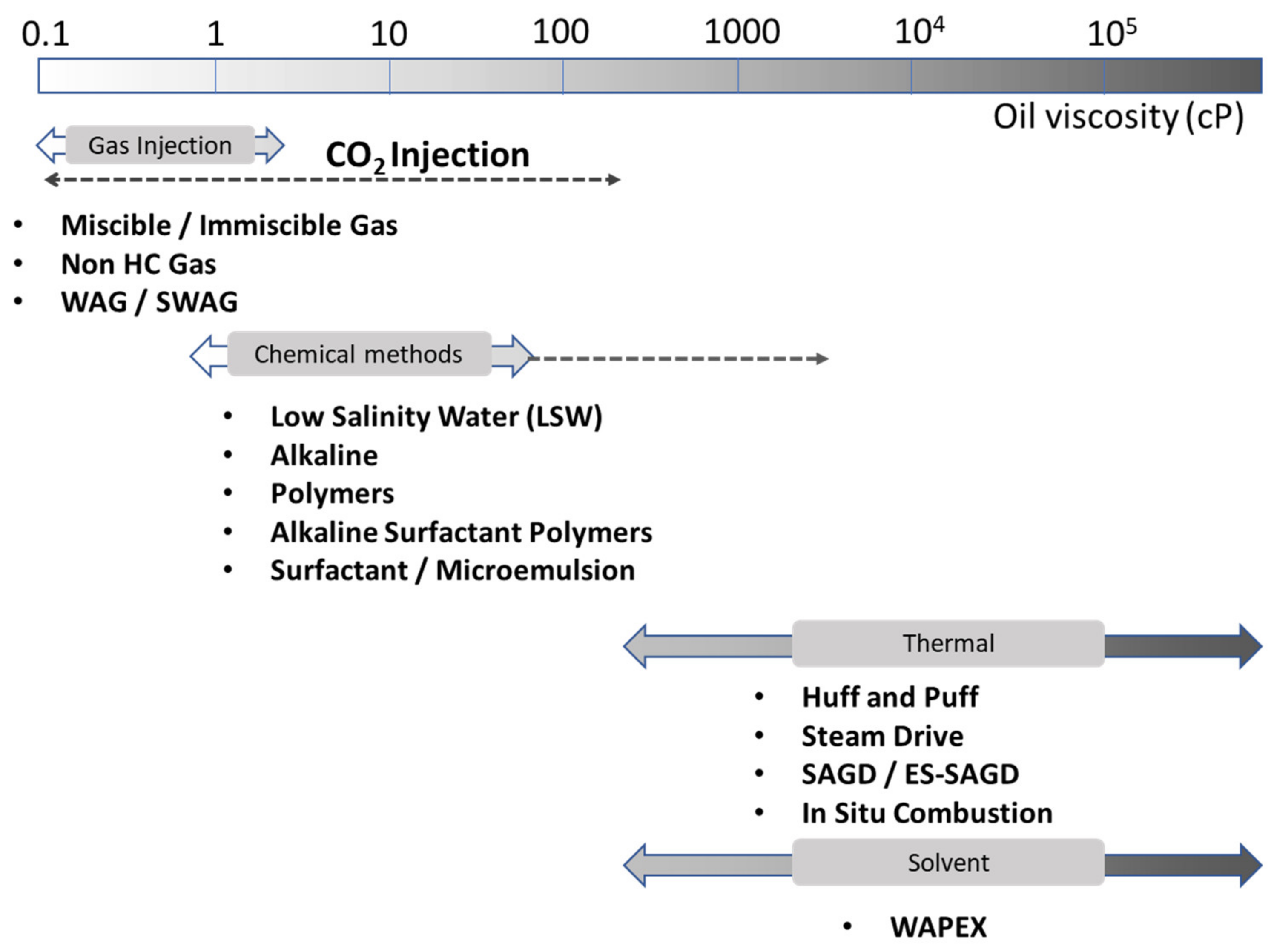
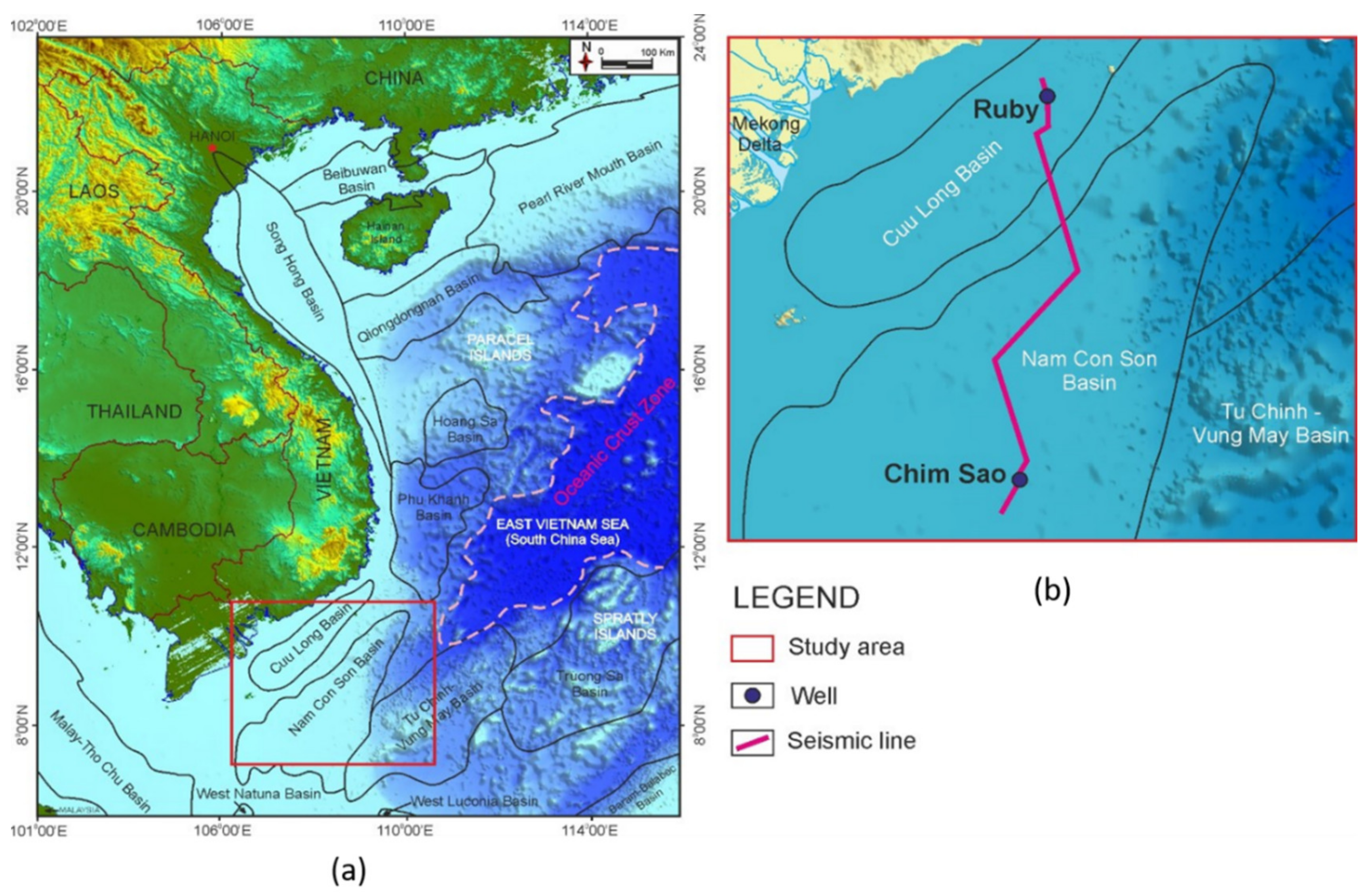
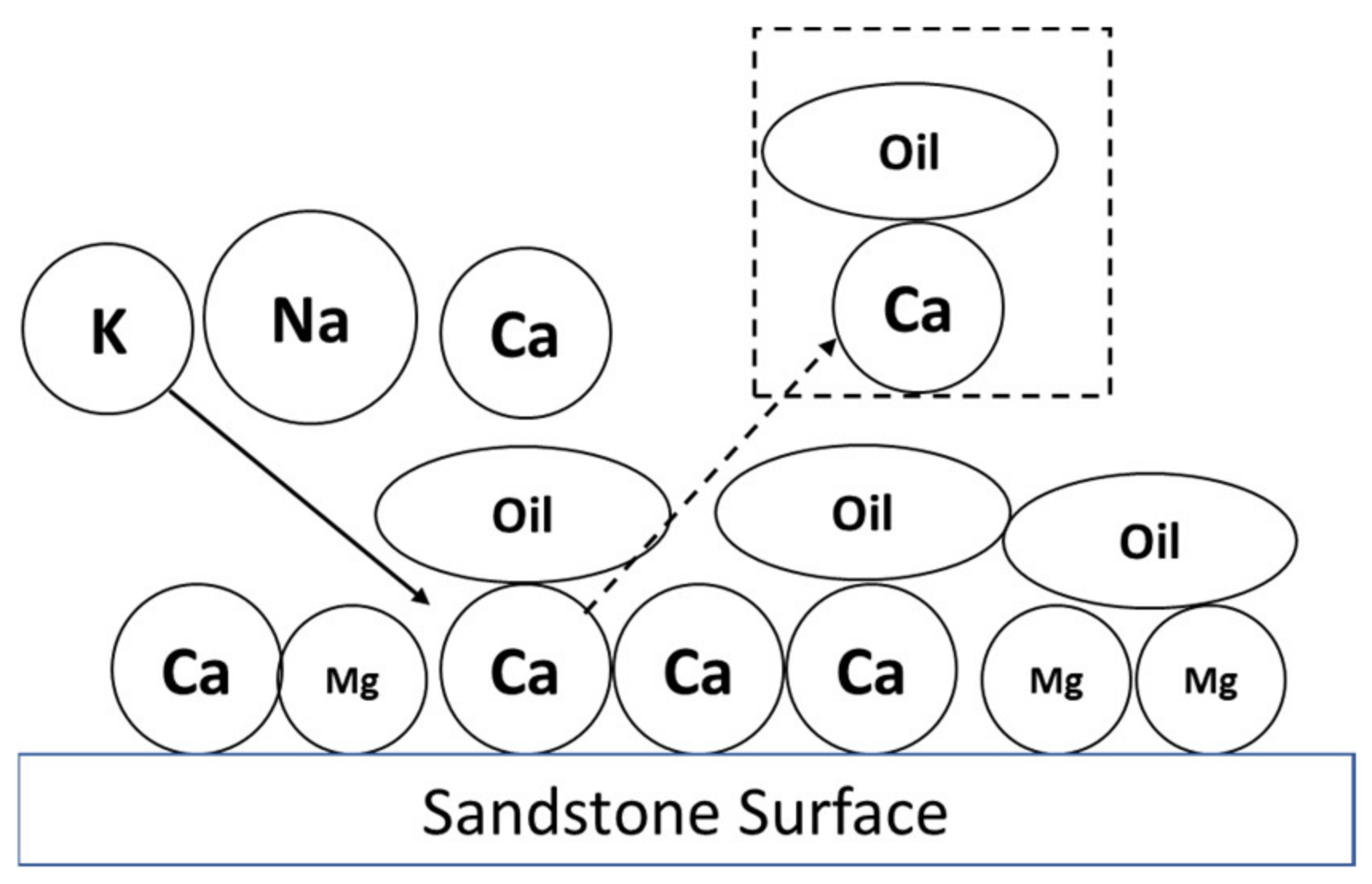

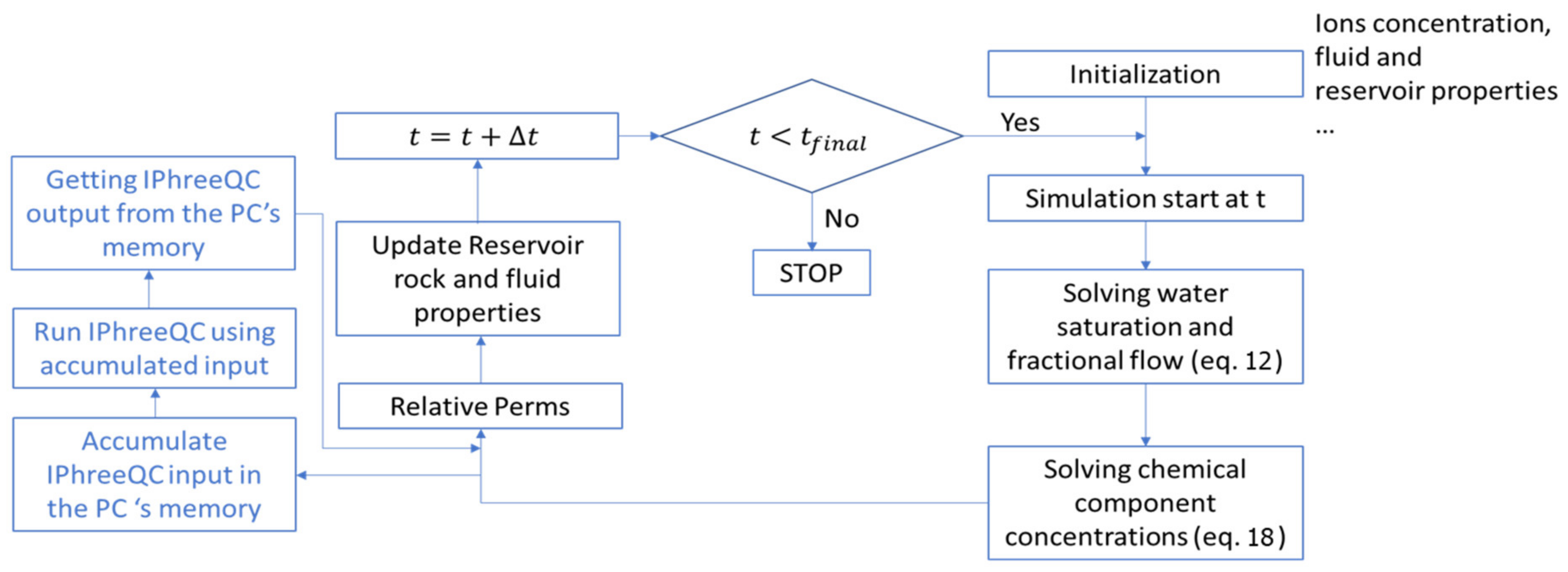

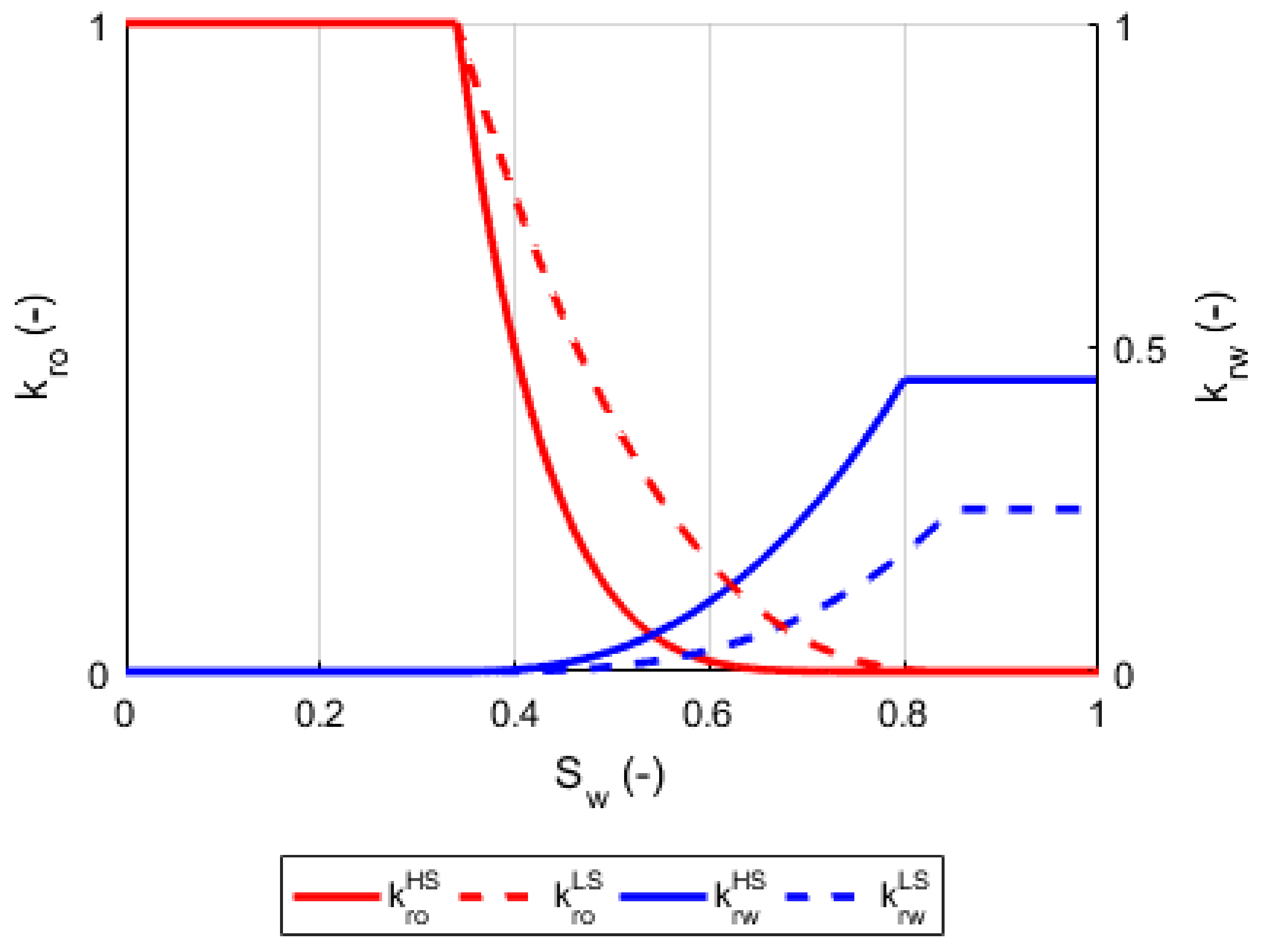

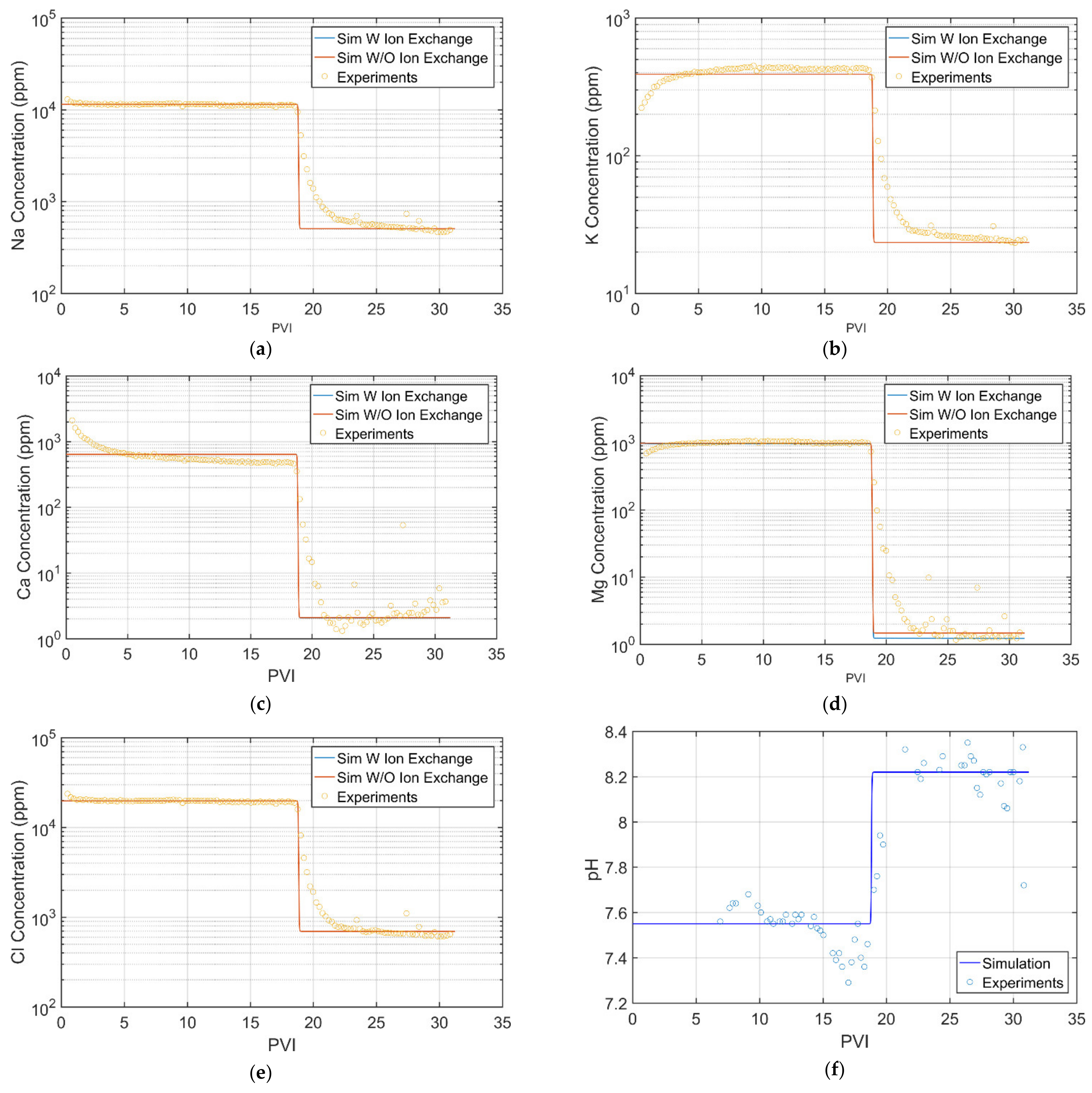

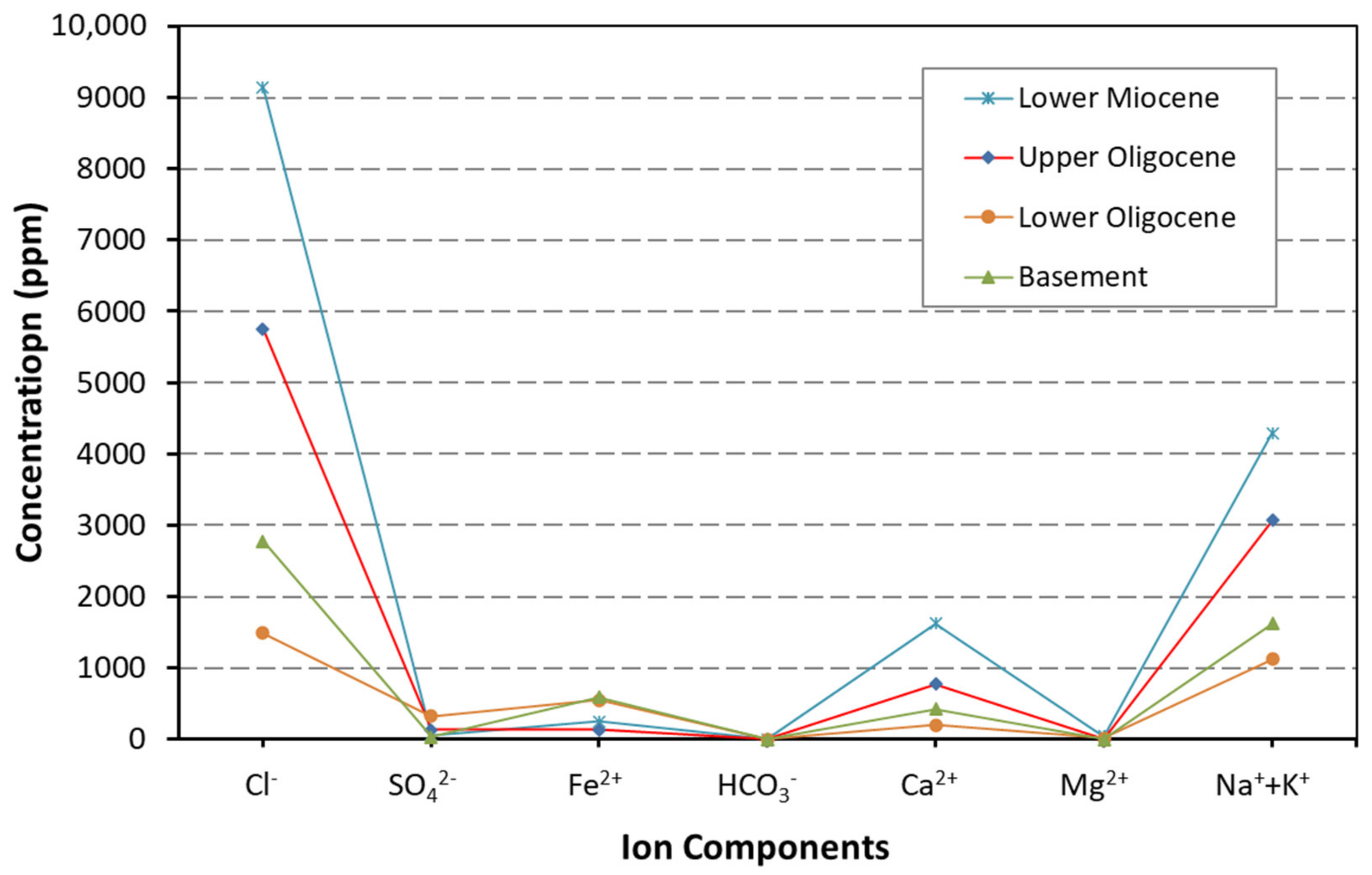
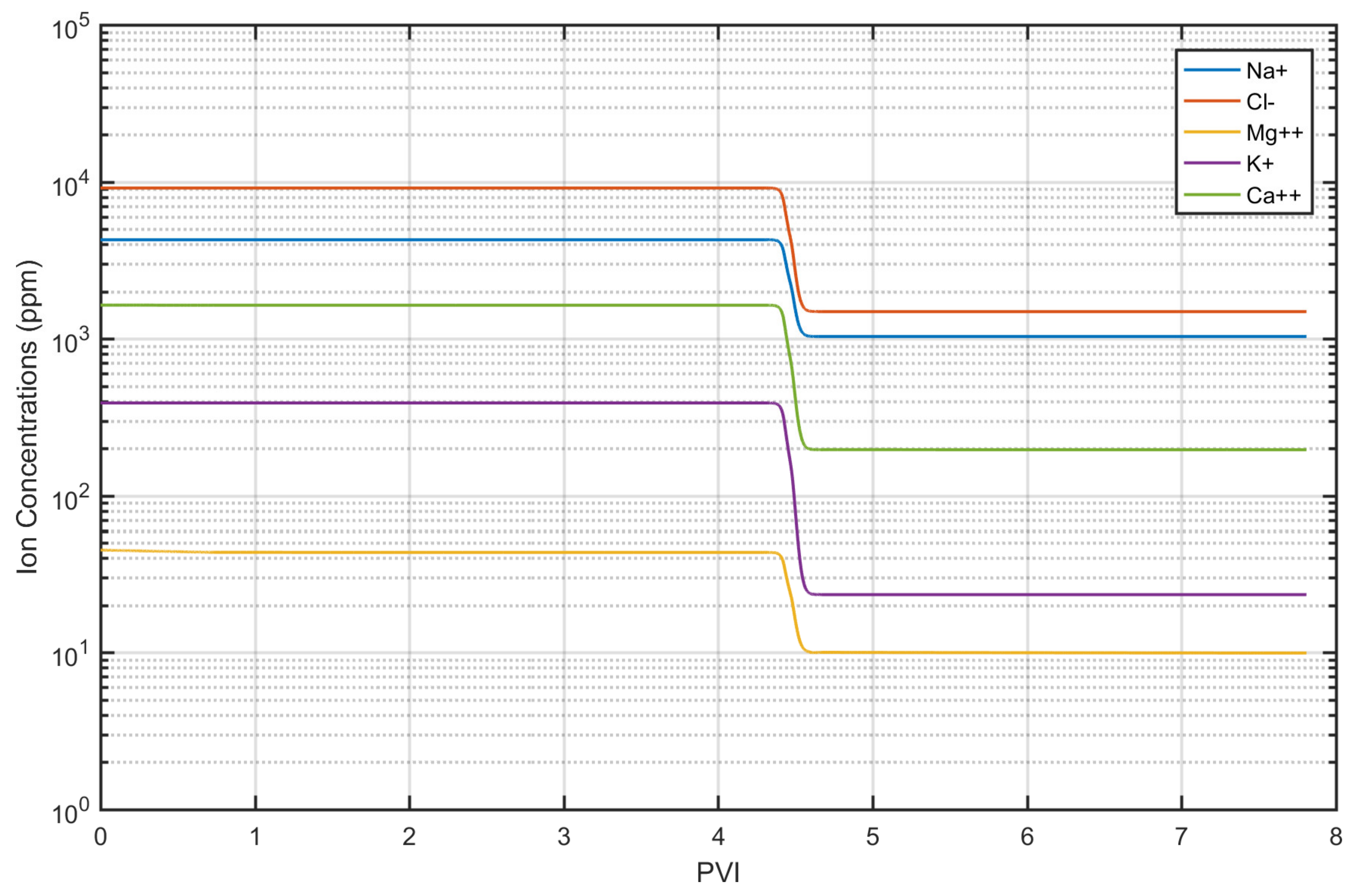
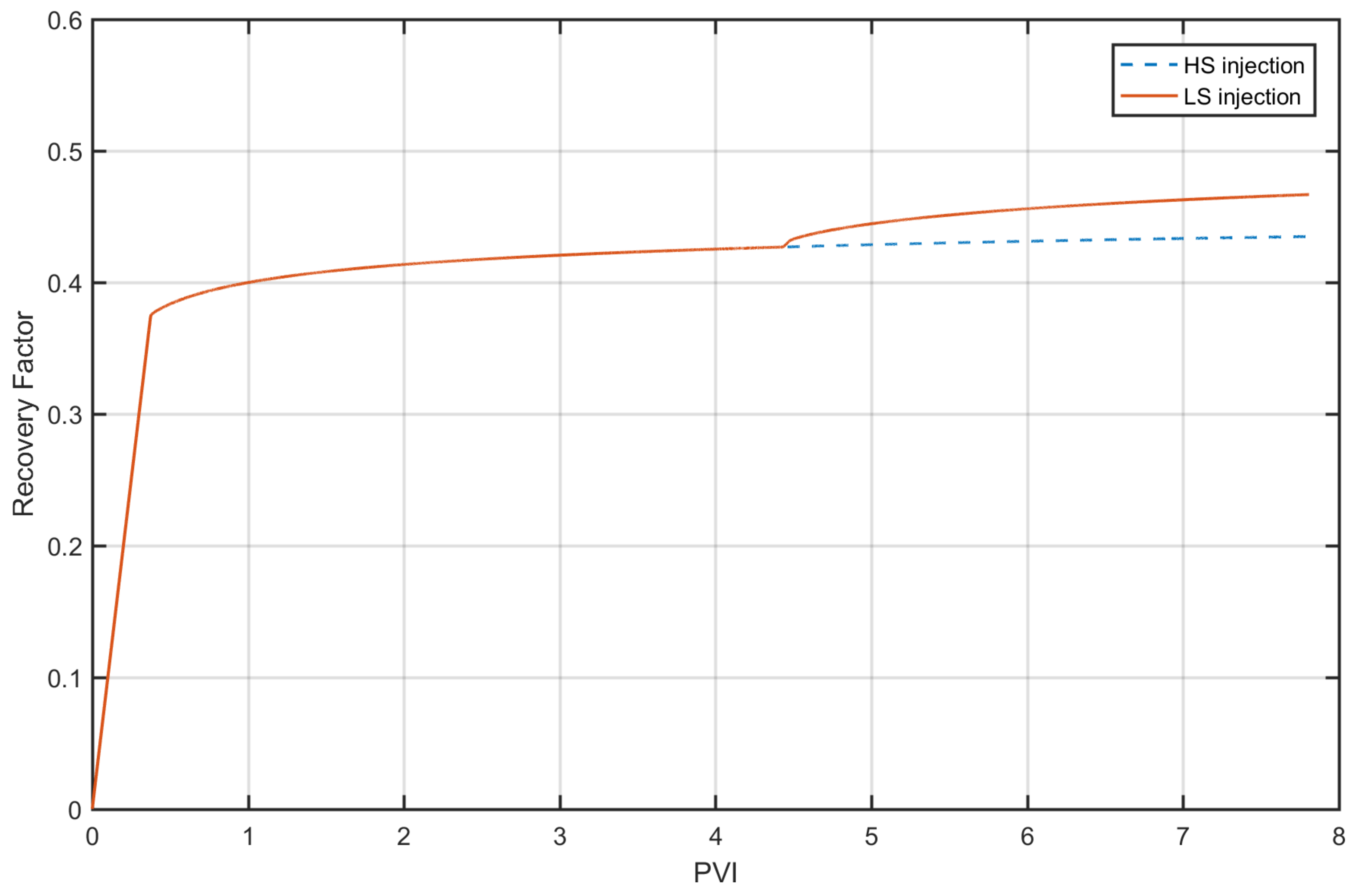
| Description | Variables | Unit | HS Value | LS Value |
|---|---|---|---|---|
| Porosity | ϕ | % | 23.4 | 23.4 |
| Absolute permeability | K | mD | 500 | 500 |
| Reservoir temperature | T | °C | 93 | 93 |
| Corey water coefficient | nw | - | 2.5 | 2 |
| Corey oil coefficient | no | - | 3.5 | 3 |
| Water viscosity | μw | cP | 0.45 | 0.42 |
| Oil viscosity | μo | cP | 3.55 | n/c |
| Initial water saturation | sw,init | % | 50 | 50 |
| Connate water saturation | sw,c | % | 20 | 20 |
| Residual oil saturation | sw,or | % | 20 | 15 |
| FW | HS | LS | ||
|---|---|---|---|---|
| Density (g/cc) | 0.996 | 0.987 | 0.972 | |
| Viscosity (cP) | 0.45 | 0.45 | 0.42 | |
| Ion concentrations (ppm) | Na+ | 12,223 | 11,345 | 3782 |
| Ca2+ | 2133 | 441 | 14.7 | |
| Mg2+ | 320 | 1075 | 35.8 | |
| K+ | 137 | 439 | 14.6 | |
| Cl− | 23,159 | 19,835 | 661.2 | |
| SO42− | 72 | 2676 | 89.2 | |
| PH | 7.55 | 8.11 | 8.21 | |
| Salinity | 38,044 | 35,811 | 1194 | |
| Description | Variables | Unit | HS Value (Lower Miocene Formation) | LS Value (Lower Oligocene Formation |
|---|---|---|---|---|
| Porosity | ϕ | % | 14.7 | 14.7 |
| Absolute permeability | K | mD | 100 | 100 |
| Reservoir temperature | T | °C | 93 | 93 |
| Corey water coefficient | nw | _ | 2.5 | 2 |
| Corey oil coefficient | no | _ | 3.5 | 3 |
| Water viscosity | μw | cP | 0.45 | 0.42 |
| Oil viscosity | μo | cP | 3.55 | n/c |
| Initial water saturation | sw,init | % | 36.5 | 36.5 |
| Connate water saturation | sw,c | % | 20 | 20 |
| Residual oil saturation | sor | % | 20 | 15 |
Publisher’s Note: MDPI stays neutral with regard to jurisdictional claims in published maps and institutional affiliations. |
© 2021 by the authors. Licensee MDPI, Basel, Switzerland. This article is an open access article distributed under the terms and conditions of the Creative Commons Attribution (CC BY) license (https://creativecommons.org/licenses/by/4.0/).
Share and Cite
Hien, D.; Giao, P.H.; Ngoc, P.Q.; Quy, N.M.; Dung, B.V.; Huy, D.D.; Giang, P.T.; Long, H. Numerical Simulation of Low Salinity Water Flooding on Core Samples for an Oil Reservoir in the Nam Con Son Basin, Vietnam. Energies 2021, 14, 2658. https://doi.org/10.3390/en14092658
Hien D, Giao PH, Ngoc PQ, Quy NM, Dung BV, Huy DD, Giang PT, Long H. Numerical Simulation of Low Salinity Water Flooding on Core Samples for an Oil Reservoir in the Nam Con Son Basin, Vietnam. Energies. 2021; 14(9):2658. https://doi.org/10.3390/en14092658
Chicago/Turabian StyleHien, DoanHuy, Pham Huy Giao, Pham Quy Ngoc, Nguyen Minh Quy, Bui Viet Dung, Dinh Duc Huy, Pham Truong Giang, and Hoang Long. 2021. "Numerical Simulation of Low Salinity Water Flooding on Core Samples for an Oil Reservoir in the Nam Con Son Basin, Vietnam" Energies 14, no. 9: 2658. https://doi.org/10.3390/en14092658
APA StyleHien, D., Giao, P. H., Ngoc, P. Q., Quy, N. M., Dung, B. V., Huy, D. D., Giang, P. T., & Long, H. (2021). Numerical Simulation of Low Salinity Water Flooding on Core Samples for an Oil Reservoir in the Nam Con Son Basin, Vietnam. Energies, 14(9), 2658. https://doi.org/10.3390/en14092658






